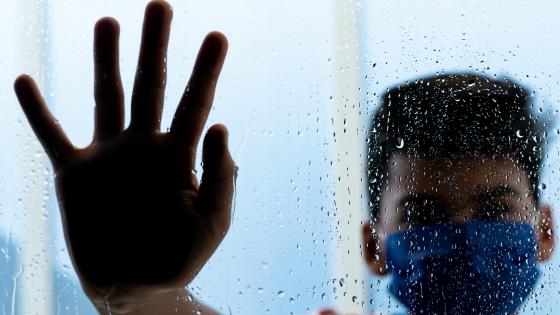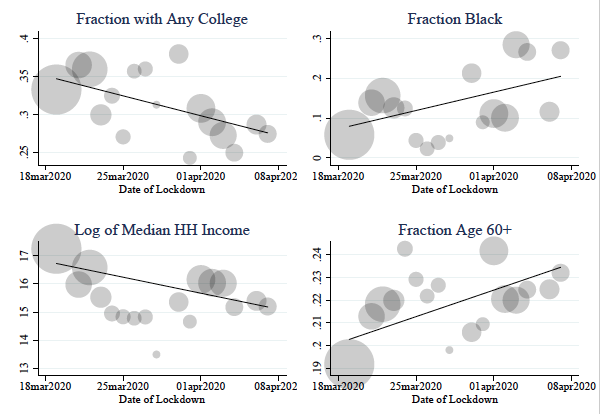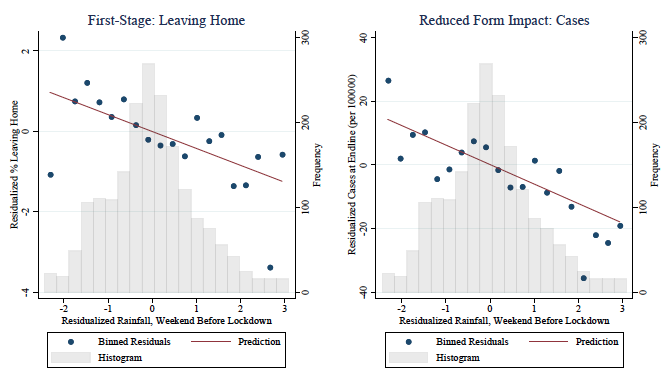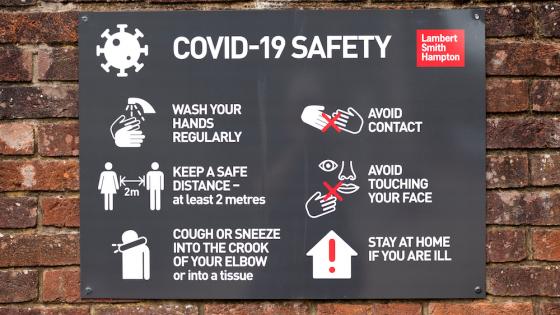As lockdowns around the world are lifted, they leave vastly different legacies. Some countries and states have suffered enormous infection and death rates while others have emerged relatively unscathed. One question of active dispute is whether earlier social distancing measures contributed to the different progression across countries. The question remains no less salient post-lockdown as many plans to reopen acknowledge that regions with new outbreaks may have to re-enter lockdown (Oliu-Barton et al. 2020). Some of these plans suggest that (re)imposing a lockdown sooner grants greater flexibility during lockdown because acting sooner will reduce the total number of infections (Baldwin 2020). These plans are based on epidemiological models that, when fitted to data on mobility in the US, imply that tens of thousands of lives might have been saved had the lockdown begun sooner (Pei et al. 2020). But since any model is only an approximation of reality, its predictions must be validated using atheoretical empirical analyses.
A credible test of whether early social distancing reduces case counts is difficult because a naïve comparison of places that began distancing earlier to those that began later may conflate correlation and causation. Figure 1 shows the correlation between the lockdown date and demographic characteristics of US states. States that issued earlier lockdowns have higher median incomes and more college degree holders, but fewer black and older residents. It is impossible to control for all differences because some do not appear in any census record. For example, the Bay Area lockdown had its roots in an association of local health officials that formed during the AIDS epidemic and has met regularly to discuss prior epidemics like Ebola and swine flu. The presence of such an institution may have had other impacts on the local response to COVID-19 beyond the lockdown, making it difficult to isolate the effect of early social distancing.
Figure 1 Correlation between the lockdown date and demographic characteristics of US states
The gold standard solution to this problem is a randomized controlled trial. A hypothetical trial would randomly assign some regions (US counties, say) to begin distancing sooner. But such a trial is infeasible and possibly unethical.
Rainfall as a natural experiment
In a recent study (Kapoor et al. 2020), we exploit a natural experiment created by rainfall. Even in the absence of an official order to stay home, people will do so anyways when the weather is foul. We exploit this fact by measuring county-level rainfall on the last weekend before the county's home state went into mandatory lockdown. This key weekend is the last day that people had wide discretion in leaving home for reasons unrelated to work (dining at restaurants, for example). We hence make within-state comparisons of counties with a lot of rainfall to counties without rain after statistically controlling for other factors that might directly affect disease transmission (temperature, for example). Since the weather does not care about a county's wealth or education or COVID-19 case rate, comparing rainy and dry counties is like having a controlled experiment that randomly assigns a small amount of extra social distancing just a few days before all the counties in the state went into lockdown.
Counties with rainy weekends suffered fewer cases and deaths in the subsequent weeks
The left-hand panel of Figure 2 shows that heavier rainfall on the weekend before lockdown caused fewer people to leave home, according to aggregated mobile phone data from SafeGraph. We confirm in the study that counties with more rain on the weekend before lockdown also had:
- Less person-to-person exposure within small commercial venues
- Fewer large gatherings
- Less long-distance travel
- Fewer out-of-county visitors
The consequences of the extra distancing are surprisingly large. We measure COVID-19 case rates and death rates 14 days after the state-wide lockdown, which is two to three weeks after the final weekend. The right-hand panel of Figure 2 shows that counties with more rain (and thus more distancing) on the pre-shut down weekend had fewer COVID-19 cases per 100,000 people. We verify that this effect is not driven by other features of the weather (temperature, humidity, etc.) that could directly affect transmission. The most plausible conclusion is that the reduction in cases is caused by the additional social distancing practiced on that one fateful weekend. Our estimates imply that a 1 percentage point increase in the number of people leaving home caused roughly 14 additional cases and 1.3 additional deaths per 100,000 people.
Figure 2 First-stage and reduced form
Figure 3 traces the impact of this one-time weekend of extra social distancing over time. Given a 1 percentage point increase in people leaving home on the final weekend, each dot shows the estimated increase in the case rate two days after state-wide lockdown, four days after, and so on. The effect keeps growing with little signs of levelling off even 18 days after the lockdown, which is some three weeks after the social distancing that induces it.
Figure 3 The excess case count in counties with less early distancing continues to increase even 18 days after lockdown
The effect is driven by a reduction in the chance of a big outbreak
The average impact on cases is driven by so-called `right tail’ events, meaning very big outbreaks. We find that a 1 percentage point increase in the number of people leaving home on the weekend before lockdown causes a 2 percentage point increase in the probability of being in the top 10% of most affected counties (Kapoor et al. 2020).
The results suggest early social distancing was effective mostly due a reduction in the chance of a big outbreak rather than by causing a moderate reduction in cases. The pattern is consistent with several recent studies that find that COVID-19 has a very low dispersion factor, meaning that small groups of “superspreaders” are responsible for the vast majority of cases (Kupferschmidt 2020). Endo et al. (2020), for example, finds that as few as 10% of initially infected people may be responsible for as much as 80% of subsequent cases. Miller et al. (2020) find very similar numbers using genome sequencing to trace the virus's spread across Israel. Early social distancing may be effective because it reduces the probability of a superspreader starting a transmission chain.
Regardless of the cause, our estimates imply that most counties that began distancing sooner experienced little benefit, but those that did benefit did so tremendously. This same fact, however, implies that earlier social distancing may prove politically difficult. Given two identical counties the one that begins distancing sooner will, in the vast majority of cases, be no better off than the other. The marginal decrease in the probability of a catastrophe will generally be undetectable even though it has enormous consequences in the aggregate.
But if policymakers can manage the political consequences, there are sizable returns. Even marginal changes—a small decrease in the number of people leaving home just a few days sooner—can have persistent repercussions. Given other work mentioned in this column which suggests that the coronavirus outbreak itself, rather than lockdown measures may be responsible for most unemployment (Baek et al. 2020), responding sooner to an outbreak may pay dividends.
References
Baek, C, P B McCrory, T Messer and P Mui (2020), "Unemployment effects of stay-at-home orders: Evidence from high-frequency claims data", VoxEU.org, 30 April
Baldwin, R (2020), "Remobilising the workforce: A two-imperatives approach", VoxEU.org, 13 April.
Endo, A, S Abbott, A J Kucharski, S Funk (2020), “Estimating the overdispersion in COVID-19 transmission using outbreak sizes outside China,” Wellcome Open Research 5 (67).
Kapoor, R, H A Rho, K Sangha, B Sharma, A Shenoy and G Xu (2020), "God is in the Rain: The Impact of Rainfall-Induced Early Social Distancing on COVID-19 Outbreaks", Covid Economics, Vetted and Real-Time Papers, 24, 1 June.
Kupferschmidt, K (2020), “Why Do Some COVID-19 Patients Infect Many Others, Whereas Most Dont Spread the Virus at All?,” Science, 19 May.
Miller, D, M A Martin, N Harel, T Kustin, O Tirosh, M Meir, N Sorek, S Gefen-Halevi, S Amit, O Vorontsov, D Wolf, A Peretz, Y Shemer-Avni, D Roif-Kaminsky, N Kopelman, A Huppert, K Koelle and A Stern (2020), “Full Genome Viral Sequences Inform Patterns of SARS-CoV-2 Spread Into and Within Israel,” medRxiv.
Oliu-Barton, M, B Pradelski and L Attia (2020), "Green zones: A proposal to exit the COVID-19 lockdown", VoxEU.org, 25 April.
Pei, S, S Kandula and J Shaman (2020), “Differential Effects of Intervention Timing on COVID-19 Spread in the United States,” medRxiv.






